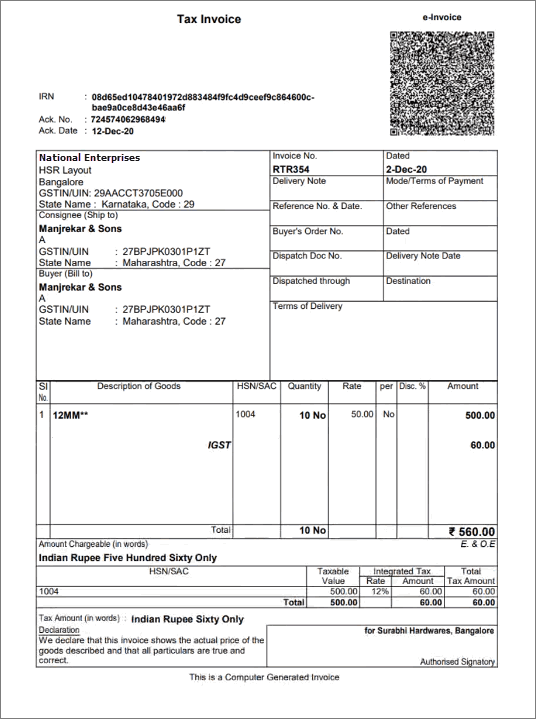
e-Invoicing under GST denotes electronic invoicing defined by the GST law. Just like how a GST-registered business uses an e-way bill while transporting goods from one place to another. Similarly, certain notified GST-registered businesses must generate e invoice for Business-to-Business (B2B) transactions.
What is E-Invoicing?

An E-invoice, or electronic invoice, is a system in which B2B invoices with some additional documents are authenticated electronically by GSTIN for further use of the common GST portal. Under the electronic invoicing system, an identification number will be issued against every invoice by the Invoice Registration Portal (IRP) to be managed by GST Network (GSTN).
Every invoice information is then transmitted from einvoice1.gst.gov.in portal to both GST portal and e-way bill portal in real-time. Thus, eliminating manual data entry while filing GSTR-1 returns as well as the generation of part-A of the e-way bills, as the information is passed directly by the IRP to the GST portal.
All invoice information gets transferred from this portal to both the GST portal and the e-way bill portal in real-time. Therefore, it eliminates the need for manual data entry while filing GSTR-1 returns and generation of part-A of the e-way bills, as the information is passed directly by the IRP to the GST portal.
Who must generate the e-invoice?
The e-invoice applicability can be explained as follows-
Transactions and documents criteria
The following transactions and documents listed below fall under
e-invoicing applicability –
| Documents | Transactions |
| 1. Tax invoices, 2. credit notes, and 3. debit notes under Section 34 of the CGST Act | 1. Taxable Business-to-Business sale of goods or services, 2. Business-to-government sale of goods or services, exports, deemed exports, supplies to SEZ (with or without tax payment), 3. stock transfers or supply of services to distinct persons, 4. SEZ developers, and supplies under reverse charge covered by Section 9(3) of the CGST Act. |
Who need not comply with e-Invoicing?
However, irrespective of the turnover, e-Invoicing shall not be applicable to the following categories of registered persons for now, as notified in CBIC Notification No.13/2020 – Central Tax, amended from time to time-
| Notified Businesses | Documents | Transactions |
| Delivery challans, Bill of supply, financial or commercial credit note or debit note, bill of entry, and ISD invoices. | Any Business-to-Consumers (B2C) sales, Nil-rated or non-taxable or exempt B2B sale of goods or services, nil-rated or non-taxable or exempt B2G sale of goods or services, imports, high sea sales, and bonded warehouse sales, Free Trade & Warehousing Zones (FTWZ), and supplies under reverse charge covered by Section 9(4) of the CGST Act. |
Systems before & after e-invoicing
Before e-invoicing, businesses generated invoices through various software, and manually uploaded them in GSTR-1 return or using ERP.
Once the respective suppliers file the GSTR-1, the invoice information gets reflected in GSTR-2B for the recipients. On the other hand, the consignor or transporters had to generate e-way bills by again importing the invoices in Excel or JSON manually or via ERP.
Under the e-invoicing system, the process of generating and uploading invoice details will remain the same. It’s all done by Tally Prime, and it generates and seamlessly flows for GSTR-1 preparation and for the e-way bill generation too.
Benefits of e-Invoicing to businesses
Businesses will have the following benefits by using e-invoice initiated by GSTN-
- e-Invoice resolves and plugs a major gap in data reconciliation under GST to reduce mismatch errors.
- e-Invoices created on one software can be read by another, allowing interoperability and helping reduce data entry errors.
- Real-time tracking of invoices prepared by the supplier is enabled by e invoice.
- Backward integration and automation of the GST return filing process – the relevant details of the invoices would be auto-populated in the various returns, especially for generating part-A of e-way bills.
- Faster availability of genuine input tax credit.
- Lesser possibility of audits/surveys by the tax authorities since the information they require is available at a transaction level.
- Faster and easy access to formal credit routes such as invoice discounting or financing, especially for small businesses.
- Improved customer relations and growth in prospects for small businesses to do business with large enterprises.
How can e-invoicing curb tax evasion?
It will help in curbing tax evasion in the following ways-
- Tax authorities will have access to transactions as they take place in real-time since the e-invoice will have to be compulsorily generated through the GST portal.
- There will be less scope for manipulating invoices since the invoice gets generated before carrying out a transaction.
- It will reduce the chances of fake GST invoices, and only genuine input tax credit can be claimed as all invoices need to be generated through the GST portal. Since the input credit can be matched with output tax details, it becomes easier for GSTN to track fake tax credit claims.
Format of sample e-invoice
The e-invoice format notified is as follows:

How does Tally e-Invoicing help?
- Get professional e-invoices with invoice reference number (IRN) and QR code
- Data remains safe & secure with TallyPrime’s own GSP (GST Suvidha Provider) technology
- TallyPrime uses the GSP route to communicate directly with the IRP
- Generate single e-invoice or in bulk
- Cancel e-invoice at the click of a button, if required
- Stay updated on pending e-invoicing tasks with one report
- Check status of e-invoicing related transactions
- Export data required for e-invoicing in offline mode to deal with possible network issues
- Software prevents, detects and corrects any exceptional errors.
